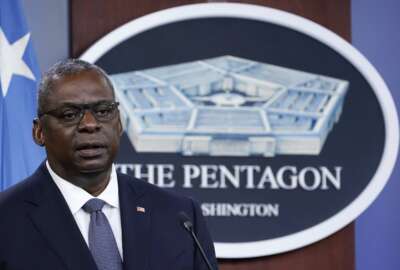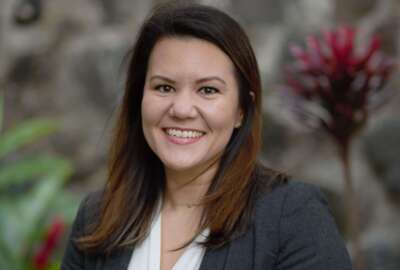Navy has a bridge all the way to Great Britain, figuratively speaking
The Percy Hobart fellowship aims to more closely link innovative elements of the private sector with the military.
Best listening experience is on Chrome, Firefox or Safari. Subscribe to Federal Drive’s daily audio interviews on Apple Podcasts or PodcastOne.
The Navy has three carefully selected delegates spending three months of learning in London. They’re part of the program known as the Percy Hobart fellowships, it aims to more closely link innovative elements of the private sector with the military. Some 40 other people from the Royal Navy and Royal Air Force will also participate. For more on what’s going on we turn to one of the Navy’s participants. Alan Jaeger is director of the Ventura Tech Bridge at the Fathomwerx lab as part of the Naval Surface Warfare Center, Port Hueneme. He spoke with the Federal Drive with Tom Temin for more.
Interview transcript:
Tom Temin: Just connect for us all of these different pieces. You’ve got the Naval Surface Warfare Center, you’ve got the Ventura Tech Bridge, you’ve got the Fathomwerx lab. Tell us about all the moving pieces here.
Alan Jaeger: Sure, a little bit complex, I guess at the first pass. Like you mentioned, I am a civilian engineer with the Naval Surface Warfare Center, Port Hueneme Division. The command, through partnerships with the local economic development collaborative, the commercial court of Hueneme, as well as a startup matter labs had formed [an] external lab called Fathomwerx. And so that is kind of our innovation lab where we can work with private sector, industry, academia, folks to help solve some of the problems that we collectively have within each organization. That’s Fathomwerx.
Tom Temin: And what are some of the typical issues you might be working on, that is, the Navy together with some of the private sector innovators locally there in Hueneme?
Alan Jaeger: Sure. So we are primarily an in-service engineering agent facility, right, focusing on how do we support the existing combat systems, weapons systems, radar systems that are on surface combatant ships. But a lot of the technologies that we’re looking at from augmented reality for maintenance and training to additive manufacturing, right, those are all similar to other things that other industries are looking at. So we have our unique kind of focus area. But at the core level, when we’re kind of first learning and experimenting with some of these technologies. There’s a lot of shared commonality that we’re trying to leverage by this space.
Tom Temin: All right, sounds like an active division going on out there. And then you were part of the Percy Hobart fellowships. Tell us about those and what you did with that.
Alan Jaeger: So kind of back in December, I was afforded opportunity, like you said to be one of the three U.S. participants in this U.K. Ministry of Defense Program. It was designed specifically to address innovation within the Royal Navy and Air Force and run out of their, what they call Office of the Chief Technology Officer for the U.K. Ministry of Defense. And so [Royal Navy] Brig. [Dan] Cheeseman, who is the chief technology officer, actually came out to Ventura County late last year, toured the Fathomwerx facility, kind of briefed on our regional innovation efforts aligned to mission, our partners and stakeholders. And so I think that probably helped influence my being invited to come participate in this program with them.
Tom Temin: And what is the purpose of the program, for us in the United States to bring innovative ideas to the British military or for them to us, or both ways?
Alan Jaeger: Both ways, right? The program has been run, this is the third cohort that the U.K. side has done. And it was really to bring some specific focus on how do we build innovation into the defense industry. And so what can we look at? What can we gain from studying private sector, from startup companies and are there some best practices that can be brought back into our larger defense type of organizations?
Tom Temin: Because in the United States, the military, in probably a dozen different programs going on throughout the military, and also at the Pentagon level, are trying to pull that innovation from the startup culture that is so prevalent in the United States? Does Great Britain have a similar type of – I mean, they have a totally different economic system. And you don’t think of them as a startup nation the way you do, say, the United States.
Alan Jaeger: Yeah, I kind of thought that too, at the beginning. And what I realized it’s actually very similar. So London itself is really a hub for innovation, second, maybe to Silicon Valley, or some of the things we think of, but they actually have a very, very innovative ecosystem within the greater U.K. area. And so much like we’re doing on the U.S. side, the Ministry of Defense side, the Royal Navy, Royal Air Force is trying to identify how do you start to work together? we tend to sit on one side of the fence or the other. And sometimes that’s kind of a barrier, a cultural barrier. How do we talk? How do we communicate and so being able to kind of embed on the other side, learn about what that looks like, hopefully helps us come together and work in ways that we hadn’t in the past.
Tom Temin: Yeah and talk a little bit over some bangers and beer I guess. We’re speaking with Alan Jaeger is director of the Ventura Tech Bridge at the Fathomwerx lab connected to the Naval Surface Warfare Center in Port Hueneme Division, that’s in Ventura, California. And what did you do over there? And how did you interact with the Brits of your counterparts? And were there also uniformed people as well as civilians involved?
Alan Jaeger: Absolutely. So it was both uniformed as well as civilian, about 40 of us total going through the program. And so being able to, again, kind of work they have their Air Force and Navy side and then of course, there are three of us from the U.S. side.
Tom Temin: And the Royal Air Force and Royal Navy, of course, are nowhere near the scale of those counterparts in the United States. But for their size, they’re pretty high tech, aren’t they?
Alan Jaeger: Absolutely. And, you know, very good partnership with each other. And so it was great to kind of see what they’re doing, like you said, a little bit smaller force. So in some ways, they can be a little bit more nimble and reactive. But then, of course, we do have a tremendous amount of resources that sometimes they don’t have. And so being able to kind of leverage and learn from both was a great opportunity.
Tom Temin: I wonder if the idea of force projection was something that was part of the topics because I’m thinking way back to the Argentine war, when the world was quite surprised at how well Great Britain could project power all the way across and down from island to the Argentines where they put down a rebellion there. This was during I guess, the Reagan era. Is that still part of the way they think about things?
Alan Jaeger: I think that that’s all part of it, right? I mean, if you look at even the namesake of the program, Percy Hobart, for those who are not familiar with Maj. Gen. Percy Hobart is somewhat of a famous military engineer and probably set some of that mindset you’re talking about Tom, where being innovative, being disruptive, being able to think through things in a little bit different way. Maj. Gen. Hobart was kind of famous for his crazy tank designs, we call him crazy, but really impacted the ability to project force, in this case, enormity, but like you said, kind of continued culturally through that evolution.
Tom Temin: All right, so what did you learn that you can bring back to the Naval Surface Warfare Center?
Alan Jaeger: Good question. I so that was kind of the point of me being there. I deliberately chose to focus my research project aligned to my home command’s goal of creating a culture of innovation in order to deliver in sustained capability. And so not just innovation for innovation sake, or what sometimes is referred to as innovation theater, but really being able to, again, align that to what we do, which is deliver and sustain capability. So had the opportunity to spend the 12 weeks and really think about, read about, learn about how companies are doing it, how the U.K. side’s doing it, and how we can bring that back to our side.
Tom Temin: And changing to that culture of innovation, that’s kind of touchy feely sounding for an engineer.
Alan Jaeger: Yeah, absolutely, right? And cultural and all that stuff, as an engineer, we get nervous with that kind of stuff. But so kind of the first part was really, to find a meaningful definition of what innovation is in terms of what we as technical and engineers kind of think of it as continuous problem solving kind of in new in different ways. And of course, as engineers, we love to solve problems. So just kind of an iterative thought process along problem solving.
Tom Temin: And also what it is you’re aiming this culture of innovation at is important, because innovation is one thing, but sustaining it in a military sense. That’s a pretty steep problem, because the military has harsh environments and dire need. And so sustainability becomes as important as the innovation. Otherwise, the innovation dies on first contact with conflict or with difficult conditions.
Alan Jaeger: Yeah, absolutely. And as an in-service engineering command, that’s exactly what we’re focused on is how do we support the men and women in the systems that they’re using for the long term, right? And not just look at the shiny object today but how are we going to sustain that capability, grow that capability, train the sailors to use that, fight with it and win with it?
Tom Temin: And is the insertion of new technology in existing chains of command existing processes? Is that also part of the thinking?
Alan Jaeger: Absolutely. Can we do some iterative process along the way? Can we do some iterative improvements that bring more capabilities to the existing systems that we have?
Tom Temin: And I imagine as a final question, you must have established some relationships that can sustain your inquiries and theirs over the long term, also.
Alan Jaeger: Yeah, in fact, right before this call I was on, we had our first kind of cohort back together. So all 40 of us, part of the program was some speakers and some lectures, some experts in the field and so even though the fellowship itself has ended, kind of a monthly basis, everyone gets together and to your point, it’s a great community of like minded folks. We can share some bangers and beer virtually but also some good ideas and keep the motivation going.
Copyright © 2024 Federal News Network. All rights reserved. This website is not intended for users located within the European Economic Area.
Tom Temin is host of the Federal Drive and has been providing insight on federal technology and management issues for more than 30 years.
Follow @tteminWFED







